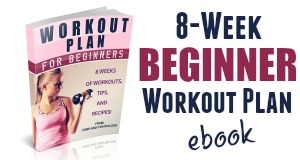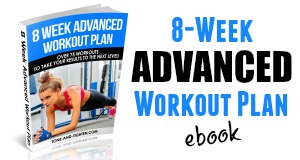Weekly highlights, new giveaways, and BONUS workouts!
Subscribe to our email list by using the red box at the top of this page.

Most of us have been there before: you just started a new workout plan. You’re a couple of weeks into it – just starting to see some really exciting progress, and WHAMMO – something starts hurting. Whether it’s your shoulder, back, neck, knee, or any other body part, nothing sidelines great progress as quickly as an injury. Suddenly we stop moving, start rehabbing, and before we know it we forget to pick up again where we left off (sound familiar?!). Well not today! This is the day we take back our fitness and eliminate those injuries from our lives! Today I wanted to share 6 things you can do right now to avoid injury and ensure you see your progress all the way through to completion of your goals! Keep reading for more…
Looking for an effective, safe way to workout from home?
Our brand-new ebook contains 30 completely unique workouts incorporating the injury-avoiding principles found in this post.
Check it out:
The “30 For 30 Workout Series” ebook!
 CLICK HERE for more information
CLICK HERE for more information
Our brand-new ebook contains 30 completely unique workouts incorporating the injury-avoiding principles found in this post.
Check it out:
The “30 For 30 Workout Series” ebook!
 CLICK HERE for more information
CLICK HERE for more informationAs a doctor of physical therapy I see a lot of patients for a lot of different reasons. Some injuries are traumatic; some develop slowly over time. But I would say a lot (if not most) of these injuries could actually be avoided if people would stick to the following six tips:
1. Avoid repetition/overuse – Ah – the overuse injury. This is probably the most-common type of injury I see. Whether it be running, lifting weights, or even home routines – people tend to get stuck in a pattern when exercising. Do you jog the same route multiple days in the week? Do you lift the same muscle groups on the same days (Mon is chest day, Tue is leg day, etc)? Or do you even do the same workout video day in and day out? You have to add some variety to your workouts to give your muscles a break and allow some time for recovery. Try supplementing your running with strength training. Do heavy weeks and light weeks in the gym with your weights, or mix up strength and cardio days. Try yoga, pilates, HIIT, Zumba, Crossfit to mix up your “normal” exercise routine. Adding variety to your workouts is a great way to avoid overuse injuries.
2. Use proper form – Hear me now and remember it always: form trumps reps and resistance EVERY SINGLE TIME. I don’t care how much of something you can lift or how many times you can do it – if you’re performing exercises with poor form you’re A) not getting the maximum benefit out of your workout and B) eventually going to hurt yourself. Form is crucial, yet it seems that no one ever really talks about it. On my YouTube channel I actually have over 75 videos demonstrating proper form for most home exercises. You can check it out here!
3. Don’t forget the stabilizers – This is one of the most-common problems that I run into with individuals who exercise regularly. Often people will train large muscle groups – their shoulders, their quads, their chest, their arms… while neglecting some of the smaller, more essential groups necessary for proper movement and mechanics. These include the rotator cuff in the shoulder, the hip abductors in the legs, and the spine/core stabilizers in the lower back (just to name a few!).
4. Warm-up, cooldown and stretch – All-too-often people jump headfirst into a workout without taking the necessary time to warm-up first. Warming up ensures that there’s some blood flowing to your major muscle groups and promotes some elasticity in the muscle (leaving it less susceptible to tearing). If you’re looking for a good warm-up, this one is awesome and only takes 3 minutes to run through!
Cooling down and stretching are essential parts of the post-workout process. A proper cool down ensures your heart rate and blood pressure return to a normal level while stretching helps to mitigate any soreness you may experience following your workout. Here are some great stretching ideas for your arms and for your legs.
5. Lift weights with a friend – Enlisting the help of a buddy can be an excellent, safe way to push yourself further then you could have otherwise. Having a spotter present during your workout not only gets you 1-2 more reps per set, but he/she can also offer meaningful encouragement. Here is a great list of workouts you can do with your buddy the next time you’re in the gym!
6. Listen to your body – Finally (and might I add most importantly) make sure you are in tune with what your body is telling you. YOU will always be the best indicator and greatest predictor of whether or not you are exercising appropriately. Muscle soreness and fatigue following a good workout is an indicator that you are on the right track. Keep going! However, sharp pain with certain movements, throbbing pain radiating from one specific location, and pain that lasts for more than 2–3 days or increases in intensity are all indicators of a more serious underlying problem. If you experience any of these it might be a good idea to lay off for a while; my recommendation would be consult with your physician to make sure you are not dealing with a more-serious problem.
Following these six guidelines is a great way to ensure a lifetime of healthy, active exercising. Try them out today, and see how far you can take your results!
Workouts, recipes, motivation, tips, and advice all right to your inbox! Subscribe to Tone-and-Tighten.com using the red bar up at the top of the page.
Looking for more amazing at-home workouts? You might be into our 8-week Beginner Workout and Advanced Workout programs! These ebooks contain over 50 workouts each, delicious healthy recipes, and everything you need to Tone and Tighten! (Click the pics below to be taken to more info about the books)
Make it happen,
Jared



